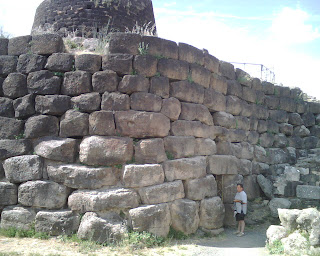The legacy between Dionysus' (Bacchus) followers, the Satyrs, and what we classify nowadays as "Sommeliers" (and Wine Sales Reps and often Wine makers).
A depiction os a Satyr on an Etruscan ceramic dated to500 b.c. found in the village of Vulci, north of Rome |
I am still trying to get rid of the dogmas I was inculcated as a child, but if I was to choose a God to worship that would be Dionysus. Of all the Gods of the Pantheon of ancient Gods, he's among the coolest, and probably the only one I would have fun hanging out with, since we have a few things in common: great taste for Wine, food, women, party, life. He puts to shame all other Gods, with the only exception of Aphrodite/Venus… She was something! What a couple would have been that one, Dionysus and Aphrodite. Sex, Wine and Rock-and-Roll!!! Don't fall in love with her though, she's likely to cheat on you...
 |
| A 500 b.c. Greek Wine cup depicting a Satyr and a Nymph |
Among the "Entourage" of Dionysus' (Bacchus) we find his closest "Aficionados": the Satyrs. Interesting little fellows, often depicted naked with a "hard-on", playing the pipe (way to go on multitasking…) and running after the "Nymphs", trying to get some action… They are "Instigators" in all the "Banquets and Orgies" that occur in the world of the Gods and Goddesses, responsible for entertaining their guests with music and libations. Not a bad job after all!
Working in the Wine Industry for about a decade gave me the chance to meet quite a lot of people. Many of them are quite knowledgeable on Wine, and many of them just enjoy it without taking it too seriously like some of us do. In the past few years however I've started noticing something very intriguing. Some of these wine buyers (and often colleagues of the Industry or even Wine Makers), and precisely the most "Enthusiastic" among them, have an "Artsy" background, a "Musical connection", or for lack of a better term "Musical Common Denominator". Being a Drummer myself, it goes without saying, I notice a "spark in their eyes" whenever we touch the "Musical" topic. I like to deviate the conversation from how the wines I am presenting to them taste to "how their Musical life is going"? The answer is almost always the same: I wish I had more time to play my instrument, my job takes most of my time…
It happens to all of us. Actually I can't complain as much anymore. Since I started a collaboration with my friend Steve Jacobson and his "The Spreading Love Project" I have been able to move my acoustic Drum Set to his studio (many of my neighbors have praised the Lord for that) and I now play at least three times a week for at least four hours straight. Not to mention I feel like I'm back in my twenties playing Rock. Cool!
Among the long list of "Fellow Satyrs" I am privileged to have met in these ten exciting years in the Industry, here are some that you may know, or heard of, or you know for sure the establishments they work in, but I bet you're not familiar with their "hidden" talents.
Taylor Parsons is the "Man behind the scene" on Osteria Mozza' s amazing Italian Wine program. I met him when he was the Sommelier for Campanile. Talking about life in general he confessed me his passion for Jazz and his Steinway Grand Piano. On a faithful Sunday afternoon I was having brunch with Taylor's dear friend Drew Langley, Sommelier at Providence L.A. And guess what I discovered? Drew is a Guitar Player and he likes to "Spin" as a DJ. But that's not the end of it! My "then" colleague Murray Proska, Sales Rep with Chambers & Chambers joined me and Drew for brunch. Why is that important? Well, obviously you don't know Murray is a "fellow Drummer" too. Do you call this a coincidence? Any ways, rumor has it that also David Rosoff, G.M. at Osteria Mozza is a Drummer. I kid you not!
Staying in the Drummer-boy realm, also Jonathan Mitchell, currently Assistant G.M. at the Palm Steakhouse in West Hollywood is a Sommelier-Drummer. He went trough several incarnations in the past few years. I met him when he ran the show at the now closed "Spazio" in Sherman Oaks, a place that used to have nightly Jazz Shows with amazing performers.
I met Mattew Kaner when he used to help George and Randy of Silverlake Wine Co. before he opened his own Wine Bar in Hollywood "Bar Covell". After befriending him on Facebook I discovered he's a Singer-Guitar player with his band "Liquid Love Letter" . Cool stuff!
So, winemakers can also play. Don't believe me? Check this out! Do you ever wonder what a Pinot Noir from Oregon would taste like if the Wine Maker was a Musician? Try the wines of Jay Somers of J. Christopher! He's a Jazzy-Rock Guitarist, and he kinda looks like a Hybrid between "Pat Metheny and Alanis Morisette's brother on a bad hair day"… I had the chance to meet him while working for Chambers, he's a very cool and down to earth dude!
O.K. let's move to Italy now. Massimo Billetto is a colleague and fellow A.I.S. Sommelier that operates and teaches out of Rome, Italy. He often appears on Italian TV shows as a food and wine critic but is also a quite good Jazz Piano Player. Staying in the same realm of Italian Wine Geeks, there is another colleague fellow-A.I.S. Sommelier, fellow NASA (we don't fly rockets) member (Actually he is the Vice-President…) Diego Meraviglia, a partner and Import Manager for Fourcade & Hecht Wines and Drummer for the band Testing Tomorrow. Now, this one is fresh just out of the boat… I mean, he just landed last night and we met and had dinner at Terroni. I am talking about Franco Piona, owner of a notable Winery in Veneto called Cavalchina. He is a Guitar player and a Drummer, and boasts friends such Steve Lukather of the 80' band Toto, famous guitar player Steve Vai and many more….
It feels just natural asking myself if it's just all a coincidence, or is it the "wine factor"? Is it the culture behind the wine? Is it the sensitive, artistic approach to life we have? Is it pure indulgence? Or is Dionysus/Bacchus still taking posses of our souls when his spirit enters our body trough the consumption of Wine, just like the ancient people believed? I don't know, all I know is that it can't be a coincidence that all these people have more than one thing in common, they share more than the passion for wine. All I also know is that after a glass of wine I play much better I step into the "Zone". What about you? Does Wine help you step "Into the Zone"?














